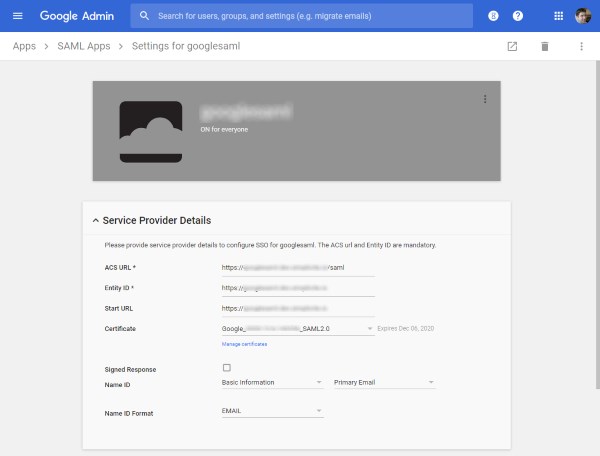SAML Authentication
The example below is given for Google SAML Identity Provider (IdP) provider but this can be transposed to other providers.
Note: This document only applies to version 4.0 and above.
Webapp settings
The changes to be done are :
- Remove all realm-related settings in
WEB-INF/web.xml(security-constraint, login-config and security-role tags) - Optionally remove also the realm definition in
META-INF/context.xml
Note: If you are using our standard Docker images or our instance templates these changes are already done
Then declare your SAML authentication provider in the AUTH_PROVIDERS system parameter, e.g.:
[
{ "name": "google", "type": "saml", "label": "Sign in with Google SAML IdP", "sync": true },
(...)
]
You can get the resulting SAML SP meta data by calling <base URL>/saml?_provider=<your provider name, e.g. gogle>&metadata
See this document for details on how to configure authentication providers.
Warning: Before doing these changes, make sure that you will still be able to login with a user having at least a responsibility on the
ADMINgroup.
Google settings
Declare a new SAML app on Google Admin Console (in Apps > SAML apps)
for the application (the SAML ACS URL and start URL will be <url>/saml):

If you configure several SAML apps you must choose a unique entity ID for each of them.
Application settings
This section is depprecated as of version 4.0.P23 for which the authentication providers configuration
is done using the AUTH_PROVIDERS JSON system parameters. See this document for details.
Add the IDP settings of your Google SAML app as system parameters:
<?xml version="1.0" encoding="UTF-8"?>
<simplicite xmlns:xsi="http://www.w3.org/2001/XMLSchema-instance" xmlns="http://www.simplicite.fr/base" xsi:schemaLocation="http://www.simplicite.fr/base http://www.simplicite.fr/schemas/base.xsd">
<object>
<name>SystemParam</name>
<action>upsert</action>
<data>
<sys_code>SAML_IDP_ENTITY_ID</sys_code>
<sys_value><![CDATA[https://accounts.google.com/o/saml2?idpid=<Your Google IDP ID>]]></sys_value>
<sys_desc>IdP entity ID</sys_desc>
<sys_type>PRV</sys_type>
<row_module_id.mdl_name>MyModule</row_module_id.mdl_name>
</data>
<data>
<sys_code>SAML_IDP_SSO_URL</sys_code>
<sys_value><![CDATA[https://accounts.google.com/o/saml2/idp?idpid=<Your Google IDP ID>]]></sys_value>
<sys_desc>IdP SSL URL</sys_desc>
<sys_type>PRV</sys_type>
<row_module_id.mdl_name>MyModule</row_module_id.mdl_name>
</data>
<data>
<sys_code>SAML_IDP_CERTIFICATE</sys_code>
<sys_value><![CDATA[[-----BEGIN CERTIFICATE-----
(...)
-----END CERTIFICATE-----]]></sys_value>
<sys_desc>IdP certificate</sys_desc>
<sys_type>PRV</sys_type>
<row_module_id.mdl_name>MyModule</row_module_id.mdl_name>
</data>
</object>
</simplicite>
Other optional settings
Depending on the SSO strategies others configurations are possible :
| System parameter | Value | Description |
|---|---|---|
| SAML_ASSERTIONS_ENCRYPTED | true/false | Indicates a requirement for the Assertions received by this SP to be encrypted |
| SAML_ASSERTIONS_SIGNED | true/false | Indicates a requirement for the <saml:Assertion> elements received by this SP to be signed. |
| SAML_AUTHNREQUEST_SIGNED | true/false | Indicates whether the <samlp:AuthnRequest> messages sent by this SP will be signed. |
| SAML_IDP_SLO_URL | Logout IDP URL | SLO endpoint info of the IdP. URL Location of the IdP where the SP will send the SLO Request |
| SAML_LOGOUTREQUEST_SIGNED | true/false | Indicates whether the <samlp:logoutRequest> messages sent by this SP will be signed. |
| SAML_LOGOUTRESPONSE_SIGNED | true/false | Indicates whether the <samlp:logoutResponse> messages sent by this SP will be signed. |
| SAML_SP_CERTIFICATE | -----BEGIN CERTIFICATE-----(...)-----END CERTIFICATE | Certificate of the SP |
| SAML_SP_PRIVATEKEY | -----BEGIN RSA PRIVATE KEY-----(...)-----END RSA PRIVATE KEY | Private key of the SP. |
| SAML_USERINFO_MAPPINGS | JSON data | User info fields mappings for synchronization (firstname, lastname, email and phone) |
Grant hooks
Then you can implement GrantHooks's parseAuth method to handle the returned
Google account identifier if required.
The example below checks and removes the domain part of the account name in parseAuth.
@Override
public String parseAuth(Grant sys, SessionInfo info) {
// Check if the account is in authorized domain
String domain = sys.getParameter("MY_GOOGLE_DOMAIN", "simplicite.fr");
// Auth string from session info after SAML authentication (e.g. username@simplicite.fr)
String auth = info.getLogin();
// Reject auth string not on domain
if (!auth.matches("^.*@" + domain + "$")) {
AppLog.globalError("Invalid domain for account = " + auth, sys);
return null;
}
// Remove domain part from the auth string to get a plain username login
return auth.replaceFirst("@" + domain, "");
}